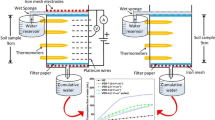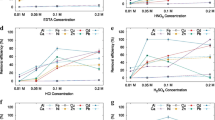Abstract
High-pressure rotary jetting (HPRJ) remediation is a recent-applied technology for in situ remediation of contaminated soils. The effectiveness of remediation depends upon the migration and distribution of the injected agents in the soil. However, the corresponding migration mechanisms have received little attention. In this study, laboratory HPRJ tests and numerical simulations were performed using chlorine (Cl−) as a tracer to investigate the transport during HPRJ and the subsequent advection and diffusion. The test results showed that the HPRJ transported Cl− into the mixing zone by eroding the sand, and the radius of the mixing zone could be reasonably predicted by the erosion model. The Cl− concentration decreased linearly along the radial direction in the mixing zone. In addition, the Cl− transport distance increased with the increase in nozzle diameter, jetting times, especially injection pressure, and decreased with an increasing rotation speed. The Cl− concentration and radial uniformity were correlated positively with rotation speed, particularly nozzle diameter and jetting times. Numerical simulation showed that part of Cl− migrated from the mixing zone to diffusion zone by advection–diffusion after rotary jetting, which contributed positively to the agent distribution distance and uniformity. The Cl− migration was dominated by advection in the initial stage (30 days), while diffusion became more important thereafter.

adapted from Ribeiro and Cardoso (2017))













Similar content being viewed by others
Data availability
The datasets used and analyzed during the current study are available from the corresponding author on reasonable request.
References
Abramovich GN, Girshovich TA, Krasheninnikov SI et al (1984) The theory of turbulent jets. Izdatel Nauka, Moscow
Aslam A, Ibrahim M, Mahmood A et al (2021) Mitigation of particulate matters and integrated approach for carbon monoxide remediation in an urban environment. J Environ Chem Eng 9:105546
Bell AL (2012) Geotechnical grouting and soil mixing. In: John B, Tim C, Hilary S (eds) ICE manual of geotechnical engineering. Thomas Telford, London, pp 1323–1341
Burke GK (2004) Jet grouting systems: advantages and disadvantages. In: Turner JP (ed) GeoSupport 2004. ASCE, Reston, pp 875–886
Cheng M, Zeng GM, Huang DL et al (2016) Degradation of atrazine by a novel Fenton-like process and assessment the influence on the treated soil. J Hazard Mater 312:184–191
Clemens S, Ma JF (2016) Toxic heavy metal and metalloid accumulation in crop plants and foods. Annu Rev Plant Biol 67:489–512
Dabbagh AA, Gonzalez AS, Pena AS (2002) Soil erosion by a continuous water jet. Soils Found 42:1–13
Davidson PA (2015) Turbulence: an introduction for scientists and engineers. Oxford University Press, Oxford
Díaz E, Tomás R (2021) Upgrading the prediction of jet grouting column diameter using deep learning with an emphasis on high energies. Acta Geotech 16:1627–1633
Duan KX, Zhang SL, Zhao BW et al (2021) Soil contamination and plant accumulation characteristics of toxic metals and metalloid in farmland soil-food crop system in Qilihe, China. Environ Sci Pollut R 28:50063–50073
Erkan İH, Tan Ö (2017) The effect of pulling and rotation speed on the jet grout columns. Int J Civ Environ Eng 10:1690–1694
Fetter CW, Boving T, Kreamer D (2017) Contaminant hydrogeology. Waveland Press, Long Grove
Flora A, Modoni G, Lirer S, Croce P (2013) The diameter of single, double and triple fluid jet grouting columns: prediction method and field trial results. Géotechnique 63:934–945
Guan CL, Yang YY (2019) Field study on the waterstop of the rodin jet pile method in a water-rich sandy gravel stratum. Appl Sci 9:1709
Hassig S, Serrano D, Villacres C et al (2021) Methodology to remediate and evaluate surface flowline capacity with coiled tubing cleanouts, SPE Annual Technical Conference and Exhibition, UAE, pp 1–13
He F, Gao J, Pierce E et al (2015) In situ remediation technologies for mercury-contaminated soil. Environ Sci Pollut R 22:8124–8147
Ho CE (2007) Fluid-soil interaction model for jet grouting. In: Hurley TM, Johnsen LF (eds) Grouting for ground improvement: innovative concepts and applications. ASCE, Reston, pp 1–10
Hu YT, Xu WJ, Zhan LT et al (2020) Quantitative characterization of solute transport in fractures with different surface roughness based on ten Barton profiles. Environ Sci Pollut R 27:13534–13549
Kamata T, Kuze N, Shimamura A, Tsuchiya T (2020) Study on repair and reinforcement for existing pile foundation using jet grouting. In: Duc LP, Dung NT (eds) Geotechnics for sustainable infrastructure development. Springer, Singapore, pp 627–634
Khan S, Naushad M, Lima EC et al (2021) Global soil pollution by toxic elements: current status and future perspectives on the risk assessment and remediation strategies-A review. J Hazard Mater 417:126039
Ma B, Wang Z, Yuan X et al (2020) In situ stabilization of heavy metals in a tailing pond with a new method for the addition of mineral stabilizers—high-pressure rotary jet technology. Environ Sci Pollut R 27:15388–15400
Mamat A, Zhang ZY, Mamat Z et al (2020) Pollution assessment and health risk evaluation of eight (metalloid) heavy metals in farmland soil of 146 cities in China. Environ Geochem Hlth 42:3949–3963
Manne A, Prasad P, Annam MK (2020) Application of jet grouting for geotechnical challenges. In: Latha GM, Raghuveer RP (eds) Construction in geotechnical engineering. Springer, Singapore, pp 565–577
Mansab S, Rafique U (2021) In situ remediation of 2, 4-dicholrophenoxyacetic acid herbicide using amine-functionalized imidazole coordination complexes. Environ Sci Pollut R 28:15099–15113
Modoni G, Croce P, Mongiovi L (2006) Theoretical modelling of jet grouting. Géotechnique 56:335-347
Momber AW (2001) Energy transfer during the mixing of air and solid particles into a high-speed waterjet: an impact-force study. Exp Therm Fluid Sci 25:31–41
Muller KA, Johnson CD, Bagwell CE, Truex MJ (2021) Methods for delivery and distribution of amendments for subsurface remediation: a critical review. Ground Water Monit R 41:46–75
Mulligan CN, Yong RN, Gibbs BF (2001) Remediation technologies for metal-contaminated soils and groundwater: an evaluation. Eng Geol 60:193–207
Munfakh GA (1997) Ground improvement engineering-the state of the US practice: part 1. Methods Proc Inst Civ Eng-Gr 1:193–214
Njock PGA, Chen J, Modoni G et al (2018) A review of jet grouting practice and development. Arab J Geosci 11:1–31
Pac TJ, Baldock J, Brodie B et al (2019) In situ chemical oxidation: lessons learned at multiple sites. Remediation 29:75–91
Qin GW, Niu ZD, Yu JD et al (2021) Soil heavy metal pollution and food safety in China: effects, sources and removing technology. Chemosphere 267:129205
Rajendran S, Priya T, Khoo KS et al (2022) A critical review on various remediation approaches for heavy metal contaminants removal from contaminated soils. Chemosphere 287:132369
Ribeiro D, Cardoso R (2017) A review on models for the prediction of the diameter of jet grouting columns. Eur J Environ Civ Eng 21:641–669
Rizwan MS, Imtiaz M, Chhajro MA et al (2016) Influence of pyrolytic and non-pyrolytic rice and castor straws on the immobilization of Pb and Cu in contaminated soil. Environ Technol 37:2679–2686
Shackelford CD (2014) The ISSMGE Kerry Rowe Lecture: the role of diffusion in environmental geotechnics. Can Geotech J 51:1219–1242
Shadman S, Chin CM, Sakundarini N et al (2022) A system dynamics approach to pollution remediation and mitigation based on increasing the share of renewable resources. Environ Res 205:112458
Shen SL, Wang ZF, Yang J, Ho CE (2013) Generalized approach for prediction of jet grout column diameter. J Geotech Geoenviron 139:2060–2069
Shih YJ, Binh NT, Chen CW et al (2016) Treatability assessment of polycyclic aromatic hydrocarbons contaminated marine sediments using permanganate, persulfate and Fenton oxidation processes. Chemosphere 150:294–303
Simpkin TJ, Palaia T, Petri BG, Smith BA (2011) Oxidant delivery approaches and contingency planning. In: Siegrist RL, Crimi M, Simpkin TJ (eds) In situ chemical oxidation for groundwater remediation. Springer, New York, pp 449–480
Tratnyek PG, Johnson RL, Lowry GV, Brown RA (2014) In situ chemical reduction for source remediation. In: Kueper BH, Stroo HF, Vogel CM et al (eds) Chlorinated solvent source zone remediation. Springer, New York, pp 307–351
Viisimaa M, Veressinina J, Goi A (2012) Treatment of Aroclor 1016 contaminated soil by hydrogen peroxide: laboratory column study. Environ Technol 33:2041–2048
Wang C, Gu L, Ge S et al (2019a) Remediation potential of immobilized bacterial consortium with biochar as carrier in pyrene-Cr (VI) co-contaminated soil. Environ Technol 40:2345–2353
Wang MM, Zhu Y, Cheng LR et al (2018) Review on utilization of biochar for metal-contaminated soil and sediment remediation. J Environ Sci 63:156–173
Wang T, Liu YY, Wang JJ et al (2019b) In-situ remediation of hexavalent chromium contaminated groundwater and saturated soil using stabilized iron sulfide nanoparticles. J Environ Manage 231:679–686
Wang Y, Li A, Cui C (2021) Remediation of heavy metal-contaminated soils by electrokinetic technology: mechanisms and applicability. Chemosphere 265:129071
Wang ZF, Shen SL, Ho CE, Kim YH (2013) Investigation of field installation effects of horizontal twin-jet grouting in Shanghai soft soil deposits. Can Geotech J 50:288–297
Wang ZF, Shen SL, Modoni G, Zhou AN (2020) Excess pore water pressure caused by the installation of jet grouting columns in clay. Comput Geotech 125:103667
Xia WY, Du YJ, Li FS et al (2019) In-situ solidification/stabilization of heavy metals contaminated site soil using a dry jet mixing method and new hydroxyapatite based binder. J Hazard Mater 369:353–361
Xie HJ, Jiang YS, Zhang CH, Feng SJ (2015) An analytical model for volatile organic compound transport through a composite liner consisting of a geomembrane, a GCL, and a soil liner. Environ Sci Pollut R 22:2824–2836
Xie HJ, Chen YM, Thomas HR et al (2016) Contaminant transport in the sub-surface soil of an uncontrolled landfill site in China: site investigation and two-dimensional numerical analysis. Environ Sci Pollut R 23:2566–2575
Yan HX, Xie HJ, Wang SY, Zheng ZJ (2021) A two-dimensional analytical model for organic contaminant transport in cutoff wall and aquifer system. Int J Numer Anal Met 45:631–647
Yuan XH, Xue ND, Han ZG (2021) A meta-analysis of heavy metals pollution in farmland and urban soils in China over the past 20 years. J Environ Sci 101:217–226
Zhang WJ, Yuan SS (2019) Characterizing preferential flow in landfilled municipal solid waste. Waste Manage 84:20–28
Zhang YF, Fu S, Liu XC et al (2013) Polybrominated diphenyl ethers in soil from three typical industrial areas in Beijing, China. J Environ Sci 25:2443–2450
Funding
This work was supported by National Natural Science Foundation of China (Grant number 41772300).
Author information
Authors and Affiliations
Contributions
Wenjie Zhang: supervision, conceptualization, methodology, writing–review and editing, funding acquisition. Yongbao Mi: investigation, methodology, writing–original draft. Weiguo Jiao: writing–review and editing.
Corresponding author
Ethics declarations
Ethical approval
Not applicable.
Consent to participate
Not applicable.
Competing interests
The authors declare no competing interests.
Consent to publish
The author warrants that the work has not been published before, and that it is not under consideration by another publication. The author also warrants that its publication has been approved by all co-authors, and by the responsible authorities at the institution where the work is carried out. The author agrees publication in Environmental Science and Pollution Research. The copyright to the article is transferred to Springer Berlin Heidelberg if and when the article is accepted for publication. The author warrants that his contribution is original and that he has full power to make this grant.
Additional information
Responsible Editor: Angeles Blanco
Publisher’s note
Springer Nature remains neutral with regard to jurisdictional claims in published maps and institutional affiliations.
Supplementary Information
Below is the link to the electronic supplementary material.
Rights and permissions
About this article
Cite this article
Zhang, W., Mi, Y. & Jiao, W. Study on the migration mechanisms of water-soluble agents in high-pressure rotary jetting remediation. Environ Sci Pollut Res 29, 74038–74050 (2022). https://doi.org/10.1007/s11356-022-21024-0
Received:
Accepted:
Published:
Issue Date:
DOI: https://doi.org/10.1007/s11356-022-21024-0




